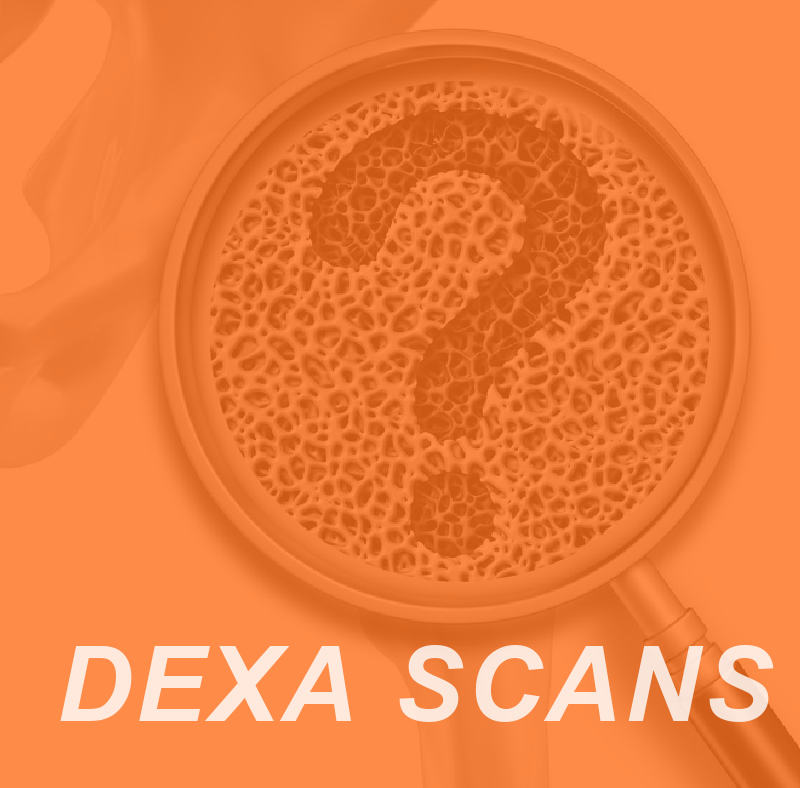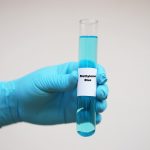
Many personal trainers wear a health and wellness cap, with interests going far beyond exercise, though it’s all interwoven. Osteoporosis and bone fractures are common issues, especially in our aging population. A DEXA scan is a non-invasive test that measures bone mineral density to assess if a person is at risk of osteoporosis or fracture. Some companies and organizations may abbreviate the scans as DXA. Understanding how screening tests like DEXA scans and prevention measures work, may be of interest to fitness professionals.
What is a bone mineral density test’s role in detecting Osteoporosis?
A bone mineral density test, sometimes just called a bone density test, detects whether an individual has osteoporosis. The word osteoporosis is a word that comes from Greek and literally means “porous bone.” People diagnosed with osteoporosis have weak, thin bones which are more likely to break. It’s referred to as a “silent condition. This means afflicted individuals don’t feel any symptoms. Usually a person will find out they have osteoporosis after a fall and resulting fracture of a bone such as the hip. Typically, people without osteoporosis would experience the same fall and an injury but most likely not a hip fracture. Without a bone density test, individuals may not realize they have osteoporosis until they break a bone.
What does DEXA Stand for and how does it work?
DEXA stands for dual energy x-ray absorptiometry. Essentially, this test utilizes x-rays to measure the thickness of a client’s bones. It also measures how much calcium and other minerals are containted in the bones along with lean and fat tissue in the body. The mineral content makeup of a human body’s bones indicates how dense and strong they are. The denser and stronger the bones are, the less likely they are to break or fracture. The lower the mineral content, the higher the chance of a broken bone.
What to Expect
Typically, the test examines the bones in your spine, hip, and forearm because these are the bones that are most likely to break when an individual has osteoporosis.
There are two types of bone density tests and they take less than 15 minutes:
Central DXA
This test looks at the spine and hip bones and tends to be more accurate.
During the test, an individual lies down on a padded platform, fully clothed. A machine arm passes above the individual, sending low-dose X-rays through the body. Based on how much the X-rays change after passing through the body’s bones, the machine comes up with an image of the body’s skeleton. The image is then read by a trained and credentialed professional.
Peripheral test
This test measures bone density at the heel, finger, and wrist. It is less thorough since it doesn’t examine the hips or spine.
The device for the Peripheral Test is portable, so it can be brought to your location or wherever the test will be done. This makes the Peripheral test accessible to more people who may not be able to get the central DXA test and is also more cost effective. Also, for clients who are in the morbidly obese category or exceptionally long-limber, they may not be able to fit the Central DXA machine, so the Peripheral test can be used in these cases.
Both are accurate measures, but the Central DXA is recommended if the client has the resources and ability to get one. This is due to the fact that the Central DXA test focuses on the spine and hips and injuries to these areas would be more debilitating than the heel, finger, or wrist. For optimal results, a client could get both the Central DXA and the Peripheral Test, but this isn’t necessary.
How to Prepare for a DEXA scan
The general instructions are to avoid wearing clothes with metal zippers, belts, or buttons. There might be others if a medical condition is present, so it’s best to check with the doctor beforehand. Overall, there is very little risk to taking the test. The human body is exposed to very low levels of radiation, less than a chest X-ray or an airplane flight.
Interpreting the Results
There will be two scores after the bone density test is completed and these scores will be compared to a reference database much like when a BMI is taken and the result is compared to a normative reference.
T score: This score compares bone density with a healthy, young adult of the same gender. The score lets the client know if the bone density is normal, below normal, or at the levels that indicating osteoporosis.
Here’s what the T score means specifically:
- -1 and above: Your bone density is normal
- -1 to -2.5: Your bone density is low, and it may lead to osteoporosis
- -2.5 and above: You have osteoporosis
Z score: This score allows the client to compare how much bone mass is present as compared with people of the same age, gender, and size.
A Z score below -2.0 means that the client has less bone mass than someone of the same age and that this could be caused by something other than aging.
Who should get a DEXA scan?
Since the DEXA Scan is a bone mineral density test, those at risk for osteoporosis are recommended to get it done.
Anyone can get osteoporosis. However, older women are more susceptible. Yet, men can get it too and the chances/prevalence increases as one ages. It is recommended to discuss this with a trained and credentialed medical prover about the test.
The doc may recommend it if any of the following criteria are met:
- A woman 65 or older
- A postmenopausal woman 50 or older
- A woman at the age of menopause and have a high chance for breaking bones
- A woman who has already been through menopause, younger than 65, and have other things that give you a higher chance of osteoporosis
- A woman who has undergone cancer therapy forcing her into an early menopause
- A man 50 or older with other risk factors
- Posture has gotten more hunched
- A broken bone after 50
- Loss of more than 1.5 inches of your adult height
- Back pain without any known cause
- History of an organ transplant
- Menses have stopped or are irregular although you’re neither pregnant nor menopausal
- Decrease in hormone levels
- If there’s a history of certain medications that cause bone loss such as:
- Cortisone (Cortone Acetate)
- Glucocorticoids
- Dexamethasone (Baycadron, Maxidex, Ozurdex) (used to treat
- Prednisone (Deltasone)
How DEXA Scans can help fitness clients
1) DEXA Scans can help clients understand their body composition
The DEXA scan provides an overview into a client’s overall level of fitness from a body composition point of view.
If a client is in the at-risk category for osteoporosis, the Fit Pro would have the results to see if the client has it or not and can modify exercise selection and programming. If the client has osteoporosis, the Fit Pro can track how the training is impacting it.
2) Measure Effectiveness of Training
Requesting a client to get a DEXA scan at various points in training can help the fit pro understand how training is affecting the client’s body composition. True, there are other ways to measure body composition, but DEXA Scans (because their use of dual-energy x-ray absorptiometry tend to be more accurate). Client’s love seeing and tracking positive results, and this is another way do it.
3) Allows clients and fit pro’s to have a baseline in case of injury
Injuries can result in temporary changes in the client’s body composition. Knowing and having accurate initial body composition values helps Fit Pro’s establish a baseline that the can be used for comparison as their client recovers. For example, if a client sprains an ankle, because of immobilization, it may atrophy. Once the client is cleared to return to exercise, having a baseline scan pre-injury can allow a Fit Pro to ensure lean mass returns to pre-injury level and potentially helping the client to prevent re-injury.
4) DEXA Scans Can Provide a Motivational Component
Because clients can be competitive or a Fit Pro can create a competition/contest between clients, the results can be motivating. One contest to consider is to offer a prize to the most documented improvements in body composition after X days/weeks/months.
Or simply, it can motivate clients to do better during their exercise program/package (i.e.: This is where you are at baseline, this is where we’d like you to be.)
5) Optimizing Exercise Design and Programming and Exercise Selection:
Because body types vary (ectomorph, mesomorph, endomorph), how they adapt to training varies. Other factors influencing exercise adaptations include age, gender, baseline/start fitness level, metabolism, nutrition, recovery rate, and the client’s physical condition/health history. Yet another one is the type of sport/exercise the client participates in. Long-distance runners versus short-burst sprinters or sprinting type activity athletes would call for differing exercise selection and programming and adaptation.
How Often Should One Get Tested?
If a client is taking medication for osteoporosis, it is recommended to do a bone density test every 1 to 2 years. Otherwise, it would depend on the client’s exercise program and goals.
How much does a DEXA scan cost?
Some insurances are starting to cover it, but many do not. Some companies will have discounts through an Employee Assistance Program or allow a Health Savings Account (HSA) payment. However, for the most part, these scans are out of pocket. Due to COVID-19 closures and now re-openings, many businesses are having specials that clients can use. Also, COVID-19 or not, many locations will offer discounted package rates. It’s best to research what’s available in your area. If there is a medical condition such as osteoporosis present, it may be covered by insurance. In this case, it is best to contact the insurance provider.
The DEXA scan can be a vital tool in detecting osteoporosis or early signs of it. It can also be used by Fit Pro’s for motivational reasons and to optimize exercise programming, design, and selection. It can also help gauge and track a client’s progress. It’s just another amazing tool in a Fit Pro’s tool belt to be able to talk to clients about. If you’re a Fit Pro that has your business, you may also get benefits by networking with the local DEXA Scan providers to help each other’s businesses and clients out.
References:
www.webmd.com/osteoporosis/guide/bone-mineral-density
www.nof.org/patients/diagnosis-information/bone-density-examtesting/








